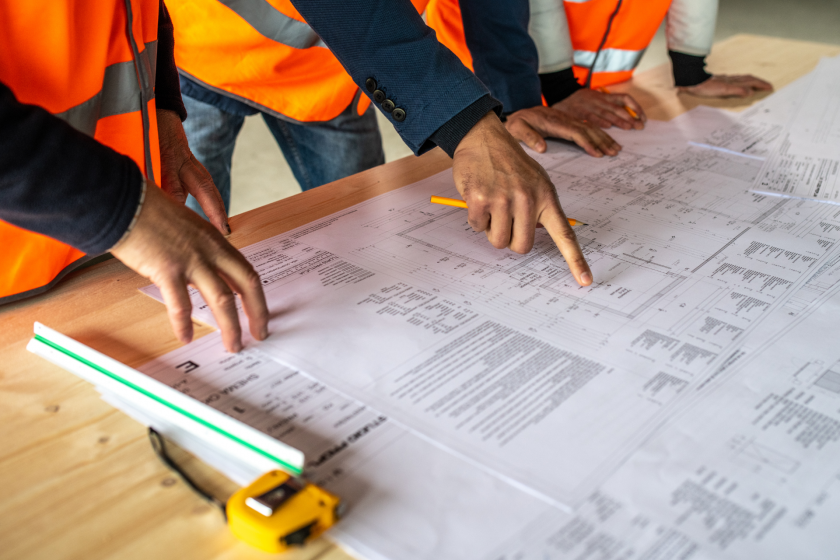Developing a construction work schedule is challenging, and delays are the order of the day in the industry.
Construction projects involve many moving parts, teams, equipment, and materials, so the construction schedule should be carefully planned.
A construction work schedule is the cornerstone of any successful construction project management. In this article, we will see how to develop it efficiently.
CONTENT
What is a construction work schedule?
A construction work schedule is a plan that organizes the activities and their sequence in a construction project.
Other elements included in a construction schedule are final results, management and resource allocation, and the budget and associated costs of all activities.
Creating a construction schedule involves comprehensive planning and the right tools.
The more time spent drafting a construction schedule, the fewer problems will be faced during project execution.
5 steps to develop an efficient construction work schedule

1. Get information
To create a thorough construction schedule, you need to know and understand every aspect of the project.
This requires a comprehensive review of plans, budgets, stakeholders, subcontractors, zoning regulations and requirements, building codes, required inspections, procurement plans, etc.
Each type of construction may present entirely different elements from other similar constructions. For example, building a villa on land in a different area may require different licenses and permits.
Therefore, all the necessary research must be done to ensure that the project complies with the requirements.
2. List and prioritize activities
Having collected the necessary information, it is time to break down the project into the steps that will take it from a construction plan to a completed project.
You cannot achieve an accurate schedule until you have a complete list of all the activities that need to be accomplished to finish a construction successfully.
Using a work breakdown structure (WBS) can provide insight into the size and scope of the project.
This methodology helps visualize the results by starting with whatever is going to be built and breaking it down level by level to the most basic parts.
The more extensive the list of activities, the more accurate the construction program will be.
3. Add duration
When the list of tasks has been finalized, you assign them a start and end date, thereby creating a bar graph, the Gantt chart, representing the duration of the different tasks.
Undoubtedly, climate and weather forecasts can seriously affect construction projects’ timelines. In this case, you can minimize the risk by looking at past weather data to understand how the weather might affect the work.
Procurement and delivery of goods and materials are other vital issues in the construction industry. You need a clear overview of what to order, when, and what suppliers are available.
It is important to make the schedule as realistic as possible.
Trying to cut corners or sacrifice the quality of work to meet the schedule can have serious consequences for the construction industry.
4. Assign and execute activities
Assigning work to teams can be confusing, as there are so many subcontractors to supervise.
At this stage, the project manager should have already made estimates of team availability and provided a detailed profile of each member’s skills and experience.
This is the only way to ensure that resources are balanced and that the construction work schedule is adhered to.
5. Continuous monitoring
Given the immensely complex construction planning, permanent monitoring of activities becomes a must.
Things can change, and if the project manager does not supervise work, the project can easily go wrong.
The schedule needs to be reviewed every day, even multiple times a day, and the work in progress must be compared to ensure progress is on track.
The RUP (Single Project Manager) plays a key role in ensuring that each project step is managed properly and that all activities are executed according to the set schedule, keeping the project on time and on budget.
Develop an efficient construction work schedule with Twproject
Progress statuses must be monitored regularly to ensure that the progress of the work is on track with the plan. Each single task must be tracked in detail, and the executive project must be followed closely to avoid errors and delays.
The financial plan must be managed accurately, considering the days needed to complete each project phase. Drafting the schedule is crucial to determine completion and execution times, ensuring that each phase of the work is planned and coordinated effectively.
From planning to project closure, this is where Twproject comes into play.
Twproject is a project management software that comes with several features that are excellent for project management in the construction industry.
This advanced tool makes it easy to plan, collect, manage, and report on work from anywhere, ultimately helping the project manager and their team be more effective and efficient.
Reports on key metrics, real-time visibility over progress, dashboards, and automated workflows keep the entire team connected and informed. It helps keep all stakeholders involved and get automated updates so they can make better, more informed decisions.
Furthermore, project planning tools such as Gantt charts, Kanban boards, and project calendars can map project activities and create accurate construction schedules.




